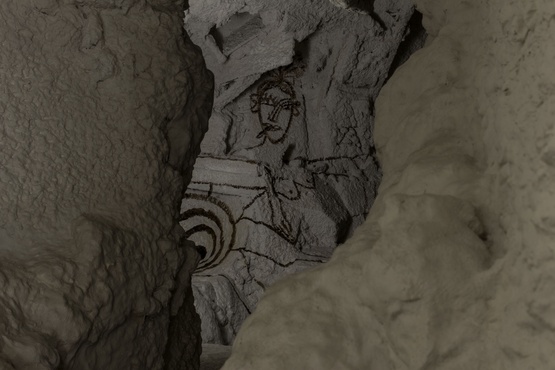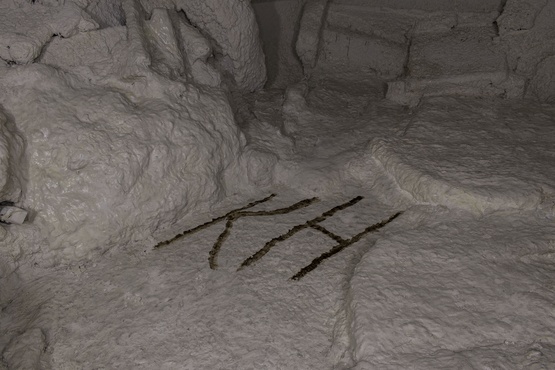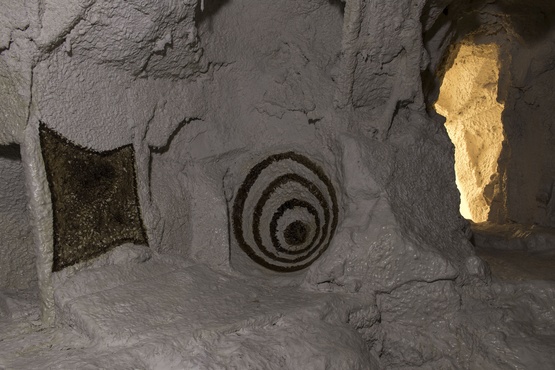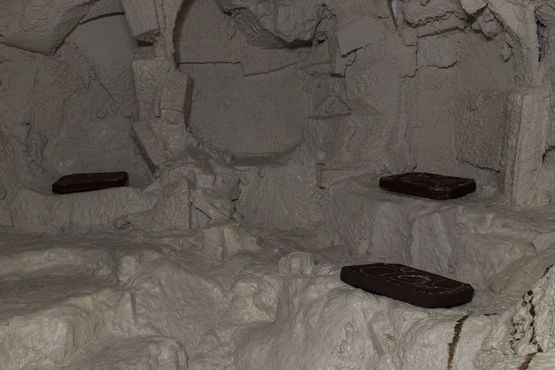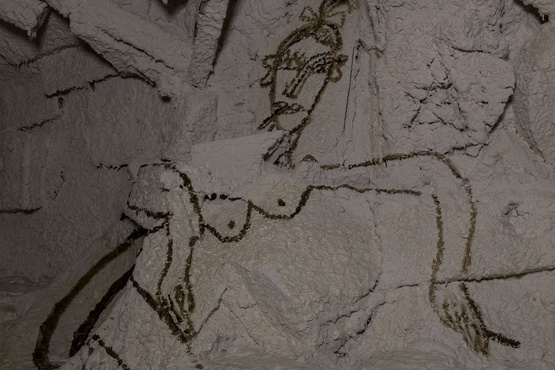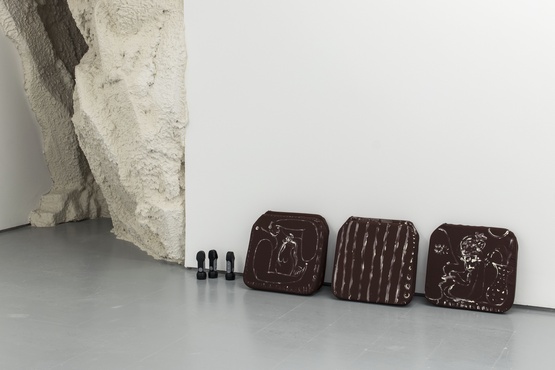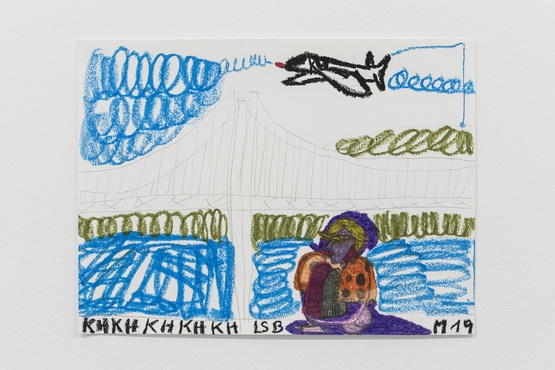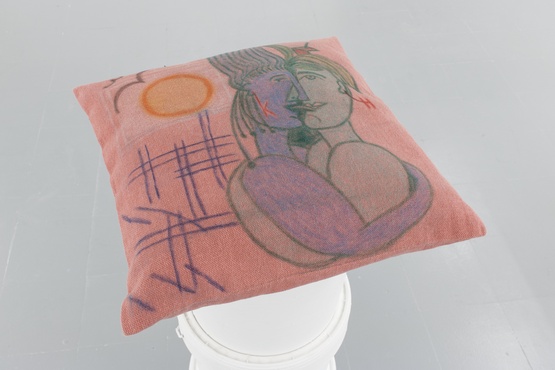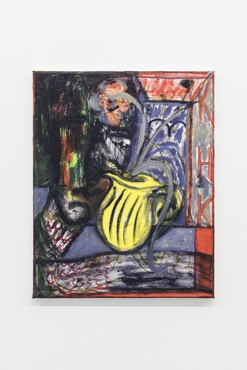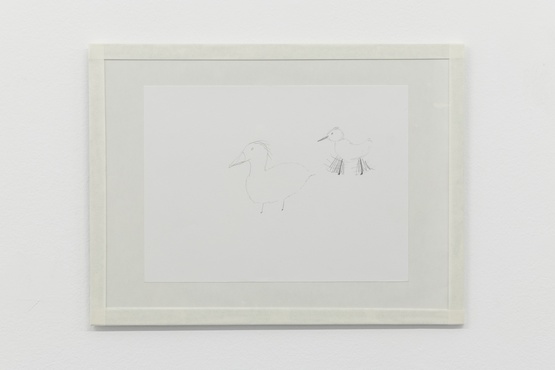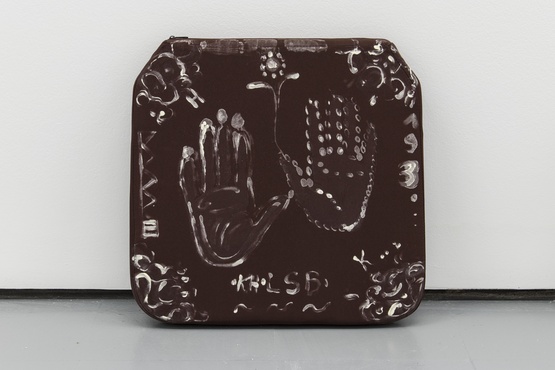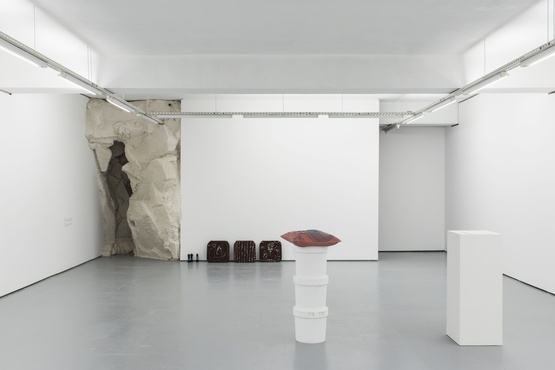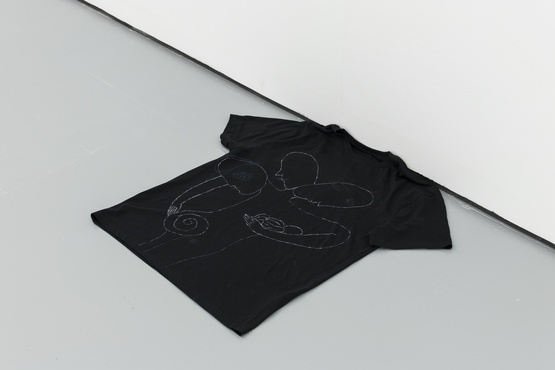It’s the Grotto’s rugged walls loaded with images that are the challenge. As opposed to the white walls of a gallery where the work is withdrawn from the world, the contours of this cave emerged from recycled materials and objects rejected by society, which carry the black cloud of the anthropocene. In a pragmatic way, the walls of this cave will always be a challenge to painters, because its protuberances and textures preclude exact lines and shapes. The scale of the cave is a challenge, as is the organic form of its non-orthogonal and non-rational plans. Besides the generosity of those who accept to work in the cave under its practical and conceptual impositions, another tangible fact is the way each intervention interferes with the previous one, and opens up to receive the interference of others, thus creating an anthropophagic and anti-capitalist metabolism.
Katharina Höglinger's intervention
inside the grotto develops around the idea of posture as part of the process of inhabiting or taking a
space, with the various assertions this implies: on the one hand, as a gesture
of a body that has its own physicality which is adapted to the characteristics
of space; on the other hand, as the adoption of a political and ethical
position, which is reflected in the way we live within a place. Like the first
hominids that left their mark on the walls of caves, Höglinger discovers a
space that already existed before her arrival. The figure represented on the walls
of the cave is seated, and its energy - present in the concentric lines - comes
precisely from that suspension. The use of pillows is part of a demand, present
in the artist's work, to respond to basic needs that arise in everyday life,
and is a first gesture in the process of inhabiting and in the search for
well-being.
Katharina Höglinger works with forces latent to her body, taken from minimal perceptions,
intimacy and inner stimuli inherent to micro-narratives, which augment the
possibilities imposed by the great social, cultural and political narratives. This differentiation is operated
through her own language, which shakes the pillars of art history, certain
jargons, and absolute truths linked to art in general and to painting in
particular.
There is a disarming lightness in
Höglinger's work that transgresses the anguish that marks our way of living in
the present. Without cowardice, her vision is made lightly, and gives back the
result of a modus operandi without the pathos of great feelings, allowing us to
see (or to live) everyday life beyond its imposed restrictions, be they the
future or death. This positive force comes free from restraint and feels like a
sort of wisdom that is the capacity of art to create new relations between
things, in a different way from science and communication, which are based on
different systems of knowledge and language.
Between lightness and gravity,
oscillating between the problems inherent to solving a painting and a personal
narrative that overlaps any logic of painting tied to academic and historical
problems, Höglinger's work shares part of her world invested in the sensible.
Sharing the sensible gains a personal clipping in the way it
"simultaneously fixes, the shared common and the exclusive parts"[1]. In other
words, the act of individuation only happens in the collective space created
between her work and the public, in the shared quotidian with the whole, and at
the same time, how she excludes herself – she marks her individuality, in the act
of painting.
Painting seems a rather natural way of
overcoming language, allowing us to see beyond the grid that shapes the way we
comprehend the world. The results of this transgression of language, and within
the inherent plasticity of painting, are figurations with a positive glow. I
write positive because "how long can culture persist without a new? What
will happen if the new ones are not capable of producing surprises? "[2]
Like a double bladed knife, Höglinger's
narrative constructions are transformed by the procedural development of
painting and vice versa. Colour is a game of intensities that goes beyond language. Sometimes, the use of colour
extrapolates figuration, giving autonomy to the painting as a surface that can
become abstract. On the other hand, the simpler figurations, resulting from an
intensity and immediacy of narrative, require in turn, a near absence of
colour.
Höglinger's painting also plays in the
arena of new subjectivities. Her paintings gain new life on social media. Here,
the subject that revolves its interior, through stimuli and sensations, marries
an external and technological subjectivity. As painting, understood as an
anachronistic medium, there is something redeeming in the way these paintings
enter and leave, infect and become infected by a seemingly disparate medium.
Katharina Höglinger (1983)
Vive e trabalha em Viena, Áustria. Licenciada em
pintura na Academia de Artes da Universidade de Linz. A sua obra tem sido
apresentada de forma regular na Austria e no estrangeiro desde 2014. Das mais
recentes exposições individuais destacam-se “a posture for something else”, TOWER, Viena (AT),”Bye now - cry
later”, White dwarf projects, Viena (AT), “How I Imagine Afterlife”, Degraw
Social Club, Nova Iorque (EUA), e “I Feel You Alive, Raumteiler, Viena (AT).
A sua obra foi integrada nos últimos anos em exposições colectivas como “The Eventuality Dispenser, comissariado por MAUVE, “Fettes College”,
Edimburgo, (IE) “on love”, Akademie Bibiliothek, Vienna (AT) “Symbolisms”, comissariado por Chris Sharp, Cooper Cole
Gallery, Toronto (CA), “worry stone, a diary”, MAUVE, Viena (AT), “Iceman and Goose”, SORT Viena (AT) e Nova Iorque (EUA), “Times New Romantic”, mi1glissé, Berlim (DE),”Limbo Nr 1”, Limbus, Basileia (CH), “Bregenz Biennale”, Bregenz
(AT), “Bones can fool people”, com Noel Ody & Helmut Heiss, Kluckyland,
Viena (AT), “9 to 5”, Warner Gallery, Toronto (CA), “Creating Common
Good”, Vienna Art Week, curated by Ursula-Maria Probst, Kunsthaus Wien, Viena
(AT), “A Conflict of Site – Helmut Heiss
& Katharina Höglinger”, Postorder Projects, Toronto, “Lote&Larp:
HAMMER&HÖGLINGER”, galerie kunstbuero, Viena (AT) e Specks, Gleisdorfergasse,
Graz (AT).
[1] in Cardoso, Miguel „Ler Rancière: a improvisação dos incompetentes“ / "To read Rancière: the incomptent's improvisation", pág. 89-111; Revista Imprópria no2; Ed. Tinta da China/UNIPOP, Lisbon, 2o semester, 2012.
[2] “…how long can a culture persist without a new? What happens if the young are no longer capable of producing surprises?” in Fischer, Mark; “Capitalism Realism – is there no alternative?”, Zero Books, Winchester (UK), 2009.



